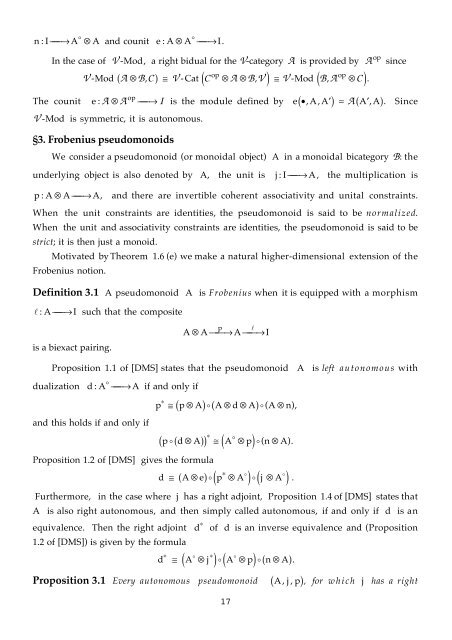Frobenius monads and pseudomonoids Introduction - ResearchGate
Frobenius monads and pseudomonoids Introduction - ResearchGate
Frobenius monads and pseudomonoids Introduction - ResearchGate
Create successful ePaper yourself
Turn your PDF publications into a flip-book with our unique Google optimized e-Paper software.
n: I æÆ æ A ƒA<br />
o<br />
<strong>and</strong> counit<br />
In the case of<br />
The counit<br />
e: A ƒA o<br />
æ æÆI.<br />
V -Mod, a right bidual for the V-category A is provided by<br />
( ) @ ( ƒ )<br />
op op<br />
V-Mod ( A ƒB,<br />
C ) @ V-Cat C ƒA ƒB,<br />
V V-Mod B, A C .<br />
op<br />
e : A ƒA æ æÆI is the module defined by<br />
V -Mod is symmetric, it is autonomous.<br />
§3. <strong>Frobenius</strong> <strong>pseudomonoids</strong><br />
( ) = ¢<br />
A op since<br />
( )<br />
e ∑ , A, A¢ A A , A . Since<br />
We consider a pseudomonoid (or monoidal object) A in a monoidal bicategory B: the<br />
underlying object is also denoted by A, the unit is j: I æÆ æ A,<br />
the multiplication is<br />
p: A ƒA æ ÆA,<br />
<strong>and</strong> there are invertible coherent associativity <strong>and</strong> unital constraints.<br />
When the unit constraints are identities, the pseudomonoid is said to be normalized.<br />
When the unit <strong>and</strong> associativity constraints are identities, the pseudomonoid is said to be<br />
strict; it is then just a monoid.<br />
Motivated by Theorem 1.6 (e) we make a natural higher-dimensional extension of the<br />
<strong>Frobenius</strong> notion.<br />
Definition 3.1 A pseudomonoid A is <strong>Frobenius</strong> when it is equipped with a morphism<br />
l :A I<br />
æÆ æ such that the composite<br />
is a biexact pairing.<br />
p<br />
A ƒA æ æÆA æ æÆI l<br />
Proposition 1.1 of [DMS] states that the pseudomonoid A is left autonomous with<br />
dualization d: A<br />
o<br />
æÆ æ A if <strong>and</strong> only if<br />
<strong>and</strong> this holds if <strong>and</strong> only if<br />
( ) ƒ ƒ<br />
( ) ƒ<br />
*<br />
p @ p ƒA<br />
o A d A o( A n),<br />
( ( ) ) @ ƒ<br />
( ) ƒ<br />
*<br />
po d ƒ A A<br />
o<br />
p o(<br />
n A).<br />
Proposition 1.2 of [DMS] gives the formula<br />
d @ ( A ƒe)<br />
o<br />
*<br />
p ƒ A o j A<br />
o o<br />
( ) ( ƒ )<br />
Furthermore, in the case where j has a right adjoint, Proposition 1.4 of [DMS] states that<br />
A is also right autonomous, <strong>and</strong> then simply called autonomous, if <strong>and</strong> only if d is an<br />
equivalence. Then the right adjoint d * of d is an inverse equivalence <strong>and</strong> (Proposition<br />
1.2 of [DMS]) is given by the formula<br />
( ) ( ƒ ) ƒ<br />
* o * o<br />
( )<br />
d @ A ƒj<br />
o A p o n A .<br />
Proposition 3.1 Every autonomous pseudomonoid ( A, j, p),<br />
for which j has a right<br />
17<br />
.
















